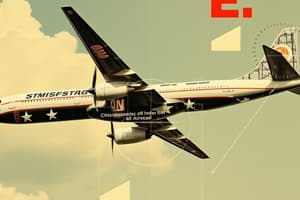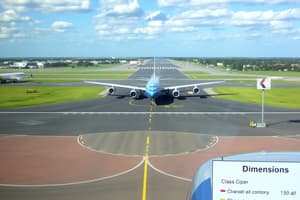Podcast
Questions and Answers
What is Class E airspace?
What is Class E airspace?
Everywhere where another airspace is not.
How can we identify distinct Class E airspaces in sectional charts?
How can we identify distinct Class E airspaces in sectional charts?
- From 1,200 FT AGL: blue vignette
- From 700 FT AGL: magenta vignette
- From the surface: dashed magenta
- All of the above (correct)
What does the acronym 'SET FOOD' stand for?
What does the acronym 'SET FOOD' stand for?
Surface airport areas, Extensions, Transition airspace, Federal airways, Off-shore airspace, Other (below & above A), Domestic enroute areas.
What is a Surface area designated for an airport?
What is a Surface area designated for an airport?
How do you recognize Surface airport areas in a sectional chart?
How do you recognize Surface airport areas in a sectional chart?
What is an Extension to a Surface area?
What is an Extension to a Surface area?
What is Transition airspace?
What is Transition airspace?
How do you recognize Transition airspace with a floor of 700 FT AGL in a sectional chart?
How do you recognize Transition airspace with a floor of 700 FT AGL in a sectional chart?
Why might you see a dashed circle inside a bigger magenta vignette circle on a sectional chart?
Why might you see a dashed circle inside a bigger magenta vignette circle on a sectional chart?
How do you recognize Transition airspace with a floor of 1,200 FT AGL in a sectional chart?
How do you recognize Transition airspace with a floor of 1,200 FT AGL in a sectional chart?
What are Federal airways?
What are Federal airways?
How do you recognize Federal airways in sectional charts?
How do you recognize Federal airways in sectional charts?
What is an Off-shore airspace area?
What is an Off-shore airspace area?
How do you recognize Off-shore airspace area in sectional charts?
How do you recognize Off-shore airspace area in sectional charts?
What are Other airspace areas?
What are Other airspace areas?
What are Domestic enroute areas?
What are Domestic enroute areas?
What are the requirements to fly in a Class E airspace?
What are the requirements to fly in a Class E airspace?
What are the VFR minimums at or above 10,000 FT?
What are the VFR minimums at or above 10,000 FT?
What are the VFR minimums below 10,000 FT?
What are the VFR minimums below 10,000 FT?
Flashcards are hidden until you start studying
Study Notes
Class E Airspace Overview
- Class E airspace, also known as "Echo," is controlled airspace not classified as A, B, C, or D, prevalent in the 48 contiguous states and Alaska.
- Identified primarily as the airspace "everywhere else."
Identification on Sectional Charts
- Floors of Class E airspace indicated by specific visual cues:
- 1,200 FT AGL: Blue vignette
- 700 FT AGL: Magenta vignette
- Surface: Dashed magenta line
Breakdown of Class E Airspace
- Class E airspace is categorized into distinct sections represented by the acronym "SET FOOD":
- S: Surface airport areas
- E: Extensions
- T: Transition airspace
- F: Federal airways
- O: Off-shore airspace
- O: Other (below & above A)
- D: Domestic enroute areas
Specific Class E Sections
- Surface Airport Areas: These are indicated by a dashed magenta area to protect instrument approach procedures.
- Extensions: Rectangular dashed magenta areas that facilitate approach procedures for Class B, C, or D airports.
- Transition Airspace: Areas facilitating traffic movement between terminal areas and enroute environments; identified by:
- 700 FT AGL: Magenta vignette
- 1,200 FT AGL: Blue vignette
- Federal Airways: "Highways in the sky," 8 NM wide, spanning from 1,200 FT AGL to 18,000 FT MSL, depicted by blue lines on charts.
- Off-shore Airspace: Designated to manage IFR separation beyond 12 NM from the coast, shown with "zipper" borders starting at 1,300 FT MSL.
- Other Airspace Areas: Extends from 14,500 FT to 18,000 FT MSL, with Class E continuing above Class A airspace up to FL 600 and beyond.
- Domestic Enroute Areas: Positioned outside or between federal airways to assist with air traffic control separation.
Flight Requirements and VFR Minimums
- Class E Airspace Flight Requirements: No specific requirements to operate within.
- VFR Minimums at or above 10,000 FT: Visibility must be at least 5 miles.
- VFR Minimums below 10,000 FT: Visibility must be at least 3 miles.
Studying That Suits You
Use AI to generate personalized quizzes and flashcards to suit your learning preferences.




